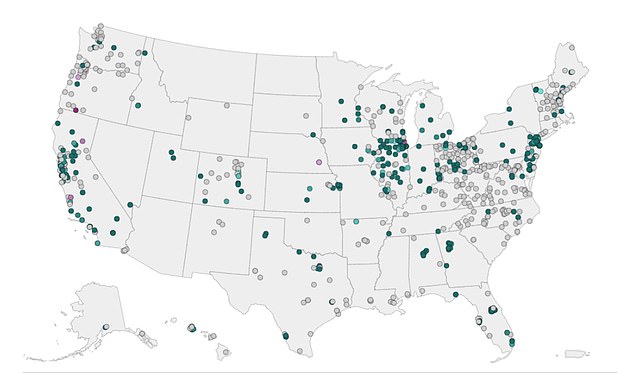Health officials are urging Americans to beware of a typical summer pastime this year
Health experts are warning that Americans attending the state fair next month should be extra vigilant about bird flu.
Popular petting zoos and popular milk demonstrations pose a major risk for the transmission of a virus that is becoming increasingly dangerous to humans.
Fourteen Americans have been infected with the H5N1 strain this year, and the White House is funding efforts to test human vaccines against bird flu in case transmission spreads further.
All of the cases this year involved contact with dairy cows or poultry, both of which are regular fixtures at state and county fairs.
State and county fairs next month will adjust their livestock screening measures to limit the risk of bird flu, with many requiring farmers to provide proof that their cows have tested negative for the virus

This interactive map shows current site-level data for influenza A virus in wastewater. Avian influenza is a strain of influenza A
Fair organizers across the country have taken precautions to keep revelers safe, primarily by restricting public access to cows. They do this by keeping people away from lactating cows and preventing spectators from milking them.
Visitors will notice big changes this summer.
For example, Minnesota will not include cows and calves in their Miracle of Birth exhibit at the state fair.
And cows exhibited at fairs in Missouri must provide proof that they have tested negative for the flu.
Over the next few months, hundreds of state and county fairs will take place across the country, with thousands of Americans petting goats, visiting barns, milking cows and watching the animals give birth.
Dr. Andrew Bowman, a professor of veterinary medicine at Ohio State University, said, “What we’re doing at trade shows is against all the principles of biosecurity that we preach. And we’re doing it in public and we’re charging for it.”
“While fairs are great for agricultural education, they create situations where multiple species from different farms are housed in one place.”
The CDC has confirmed 14 cases of bird flu in poultry and dairy farmers since 2022. Colorado now has nine cases.
The public health agency has launched an online tracking dashboard based on surveillance of wastewater samples.
The dashboard is based on wastewater samples that test positive for A-type influenza viruses, such as the H5N1 strain that infects cattle on U.S. dairy farms. The data is presented in a map format and compares positive tests to the same period last year to see if there are any increases.
The University of Minnesota Extension, a public health extension agency, last week released guidelines for fairs that feature cow exhibits.
The advice is not to send dairy cattle to trade fairs until 2024, because raw milk contains high concentrations of the bird flu virus.
And fans of the Minnesota Miracle of Birth Center, where visitors can watch cows and other livestock give birth, won’t be bringing any cows this year.
Mother cow-calf pairs are still on display at the fair, but the mother cows are no longer producing milk and the calves are being weaned.
More and more state and provincial fairs are also having veterinarians on hand to check that cows entering the fairgrounds have tested negative for influenza.
Dr. Tia Kastenson, Wisconsin’s veterinary director, said, “They collect the paperwork, make sure all the lactating cows have their (test) dates, and then they monitor the cows as they come off the trailer.
“If there is anything questionable, they take (the cows) out before they go into the barn.”
Farmers bringing their lactating dairy cows to the Missouri State Fair next month must have the animal’s milk tested for H5N1 no later than a week before arriving. Those arriving at the fair with dairy cows that haven’t been tested will be turned away.
The fair organizers have also chosen to close off the area where visitors can milk cows themselves.
Missouri State Veterinarian Dr. Steve Strubberg said, “Once (avian flu) is present in a cow, it spreads to herd mates through the milking process.
‘For that reason, the State Fair Commission will not allow regular exhibitors to use the milking parlor in a manner in which they would use the same equipment for transporting one cow and one herd to another.’
The risk of non-farmers catching bird flu is low thanks to the power of pasteurization, which kills bacteria and viruses in milk before it reaches the stores.
According to the U.S. Department of Agriculture (USDA): “At this time, there are no concerns about the safety of the commercial milk supply or that this condition poses a risk to consumer health.”
The CDC on Tuesday announced a $10 million budget to help combat the spread of bird flu among farm workers, with millions earmarked to help vaccinate them against various strains of flu, including bird flu.
Nirav Shah, director-in-chief of the CDC, said, “By preventing seasonal flu in these workers, many of whom are also exposed to bird flu, we can reduce the chance of new flu strains emerging.”
